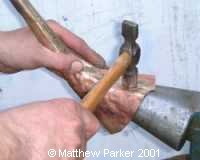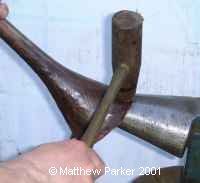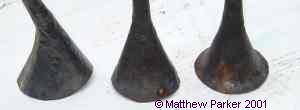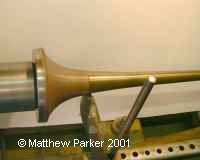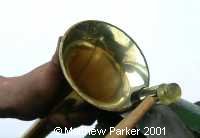Trumpet Making |
| All Matthew Parker
Trumpets are hand made. The main part of the natural trumpet, the bell, starts out as a flat sheet of metal cut into a shape providing the right amount of metal at each point along the bell.
This is then folded along it length and the area of the flare 'pegged out' by hammering on a wood block to stretch the metal of the flare opposite the seam. This allows the two edges to be brought together to form an overlapping seam the length of the bell.
Tabs are
formed at points on the seam to keep it together whilst
it is being soldered together with a brass solder or spelter. |
| When soldered the seam is
planished (hammered) to make it the same thickness as the original sheet.
|
| The bell is then 'stamped
out' on a mandrel (a steel bell shape) to get it a good fit on the mandrel.
This involves hammering and frequent softening (annealing)
of the metal.
|
| This picture shows the
development of the bell shape during planishing and stamping out.
|
| Finally the bell is spun on a lathe, and by using a wooden tool followed by metal
tool, the bell is made to take the exact shape of the
mandrel. Alternatively the bell would be burnished by
hand to conform to the mandrel. This is a much more time
consuming (and costly) method, used before the advent
of lathes powerful enough for spinning.
|
| After the bell has been
cleaned and polished, a garland (a piece to double the
thickness of the flair to strengthen it) is added.
|
| Finally a wire is
soldered to the garland to provide additional support to
the flair rim.
|
| The tube for the rest of the trumpet was originally
made from sheet metal in a similar manner to the bell.
|
| The bending of tube for
the bows and crooks is done by filling the tube with a
soft metal such as lead, allowing bending of the tube without it
collapsing. Bending is done by hand using a former of the
required shape. The metal being melted out after the bend
is formed.
|
|
For further information |


